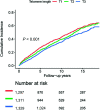Shortened Leukocyte Telomere Length Is Associated With Glycemic Progression in Type 2 Diabetes: A Prospective and Mendelian Randomization Analysis
- PMID: 35085380
- PMCID: PMC8918237
- DOI: 10.2337/dc21-1609
Shortened Leukocyte Telomere Length Is Associated With Glycemic Progression in Type 2 Diabetes: A Prospective and Mendelian Randomization Analysis
Abstract
Objective: Several studies support associations between relative leukocyte telomere length (rLTL), a biomarker of biological aging and type 2 diabetes. This study investigates the relationship between rLTL and the risk of glycemic progression in patients with type 2 diabetes.
Research design and methods: In this cohort study, consecutive Chinese patients with type 2 diabetes (N = 5,506) from the Hong Kong Diabetes Register with stored baseline DNA and available follow-up data were studied. rLTL was measured using quantitative PCR. Glycemic progression was defined as the new need for exogenous insulin.
Results: The mean (SD) age of the 5,349 subjects was 57.0 (13.3) years, and mean (SD) follow-up was 8.8 (5.4) years. Baseline rLTL was significantly shorter in the 1,803 subjects who progressed to insulin requirement compared with the remaining subjects (4.43 ± 1.16 vs. 4.69 ± 1.20). Shorter rLTL was associated with a higher risk of glycemic progression (hazard ratio [95% CI] for each unit decrease [to ∼0.2 kilobases]: 1.10 [1.06-1.14]), which remained significant after adjusting for confounders. Baseline rLTL was independently associated with glycemic exposure during follow-up (β = -0.05 [-0.06 to -0.04]). Each 1-kilobase decrease in absolute LTL was on average associated with a 1.69-fold higher risk of diabetes progression (95% CI 1.35-2.11). Two-sample Mendelian randomization analysis showed per 1-unit genetically decreased rLTL was associated with a 1.38-fold higher risk of diabetes progression (95% CI 1.12-1.70).
Conclusions: Shorter rLTL was significantly associated with an increased risk of glycemic progression in individuals with type 2 diabetes, independent of established risk factors. Telomere length may be a useful biomarker for glycemic progression in people with type 2 diabetes.
© 2022 by the American Diabetes Association.
Figures


References
-
- Lawes CM, Parag V, Bennett DA, et al. .; Asia Pacific Cohort Studies Collaboration . Blood glucose and risk of cardiovascular disease in the Asia Pacific region. Diabetes Care 2004;27:2836–2842 - PubMed
-
- Turner R, Stratton I, Horton V, et al. .; UK Prospective Diabetes Study Group . UKPDS 25: autoantibodies to islet-cell cytoplasm and glutamic acid decarboxylase for prediction of insulin requirement in type 2 diabetes. Lancet 1997;350:1288–1293 - PubMed
-
- Jiang G, Luk AO, Tam CHT, et al. .; Hong Kong Diabetes Register TRS Study Group; Hong Kong Diabetes Biobank Study Group . Obesity, clinical, and genetic predictors for glycemic progression in Chinese patients with type 2 diabetes: a cohort study using the Hong Kong Diabetes Register and Hong Kong Diabetes Biobank. PLoS Med 2020;17:e1003209. - PMC - PubMed
Publication types
MeSH terms
Associated data
LinkOut - more resources
Full Text Sources
Medical

